토플 주니어
TOEFL® Junior™ Standard
영어 원문 다운로드중학생 ~ 고등학생
중/고등학교에서 학습하고 생활하는데 필요한 영어 능력을 평가하는 시험으로 다음 사항에 대한 이해를 테스트한다.
• 듣기 시험은 대화나 강의 등 실제 접할 수 있는 상황을 소재로 미국,영국,호주 등 다양한 발음으로 개별문항 (1개의 대화에 1문항),
또는 세트문항 (1개의 독백 또는 대화에 3개 이상의 문제)으로 구성
• 언어구조와 의미 시험은 서신,광고, 기사 등 다양한 지문에서 문장의 구조와 문맥을 바탕으로 적절한 어휘와 문법 사항을 선택하여 전체의 흐름으로 파악하고 이해할 수 있는 능력을 평가
• 읽기 시험은 일정, 이메일, 과학/사회 등의 아카데믹한 내용의 긴 단락을 이해하고 논리적인 사고를 통해 정답을 가려낼 수 있는 능력을 평가
| 평가 영역 | 문항 수 | 시험시간 |
|---|---|---|
| Listening Comprehension | 42 | 40분 |
| Language Form and Meaning | 42 | 25분 |
| Reading Comprehension | 42 | 50분 |
영역별 능력 평가
-
Listening Comprehenion Test는
다음과 같이 학생들의 능력을 평가한다.1. 학교에서의 공지, 발표 등을 듣고 이해하는 능력
2. 일상 생활에서의 대화를 듣고 이해하는 능력
3. 수업, 토론 등을 듣고 이해하는 능력
듣기 지문은 대화나 강의 등 종류가 다양하며 실제로 할 수 있는 상황을 다루고 있습니다.
실제로 말을 주고 받을 때의 현장감을 최대한 자연스럽게 반영하고 있으며, Note-taking을 할 수 있으므로 단순히 기억력에 의존하여 문제를 풀기보다는 내용을 이해하고 정리하는 능력을 더 필요로 합니다. -
Language Form and Meaning Test는
다음과 같이 학생들의 능력을 평가한다.영어 문장의 구조와 어휘에 대한 이해를 평가
전체 문맥의 흐름을 파악하고 오류를 잡아내는 능력을 측정
한 문단(10~11 문장) 8~9 문항으로 구성
다독 및 어법에 초점을 맞춘 꾸준한 훈련 필요
-
Reading Comprehenion Test는
다음과 같이 학생들의 능력을 평가한다.1. 학문적 지문을 읽고 이해하는 능력
2. 비학문적 지문을 읽고 이해하는 능력
독해 영역은 단순한 문장 해석과 문제 풀이를 벗어나 논리적인 사고를 통해 정답을 가려 낼 수 있는 능력을 평가합니다.
비 학문적, 학문적인 지문이 골고루 등장하나 TOEFL iBT와 달리 문제를 해결하는데 필요한 모든 정보가 지문 안에 있기 때문에 특별한 배경 지식은 필요로 하지 않습니다.
Listening 질문유형 (Example Question)
학생들은 영어로 녹음된 다양한 대화와 대화를 바탕으로 질문에 답해야 한다.
첫 번째 유형은 교사나 다른 학교 직원이 학생들과 대화하는 것이다.
각각의 대화는 한 가지 질문이 뒤따른다.
각 질문에 대한 가장 좋은 답을 선택하고 답안지에 정답의 글자를 표시하라는 요청을 받게 된다.
학생들은 각각의 대화를 한 번만 들을 것이다.

(Narrator): Listen to a school principal talking to a group of students.
(Woman): I was very pleased by your band’s performance at the holiday festival. I don’t often see students playing their own music. Student bands usually play something traditional, but you actually composed something original. That’s really impressive!
(Narrator): What did the principal like best about the band?
The students see in their tests books:
1. What did the principal like best about the band?
(A) The students wrote their own music.
(B) The band played several kinds of music.
(C) The band played during the whole festival.
(D) The students played many different instruments.

(Narrator): Listen to a science teacher talking to her students.
(Woman): First, we are going to collect some leaves that have fallen from the trees. Then, we will compare the colors of those leaves. After that, we will use the leaves to make a poster about what happens to trees during autumn. OK, now put on your jackets and let’s head outside.
(Narrator): What will the class probably do next?
The students see in their tests books:
2. What will the class probably do next?
(A) Design a poster
(B) Color the leaves
(C) Eat lunch outside
(D) Collect fallen leaves
두 번째 유형의 대화는 짧은 대화를 포함할 것이다.
각 대화마다 3개 이상의 질문이 뒤따른다.
학생은 각각의 질문에 대한 가장 좋은 답을 선택하라는 질문을 받게 될 것이다.
그 대화는 한 번만 들을 것이다.

(Narrator): Listen to a conversation between two students at school.
(Girl): Hi, Tommy. Are you on your way to the cafeteria?
(Boy): [answering, but distracted as he is looking for something] No—I was on way to the library to return a book, but now I’m looking for my watch. It must’ve fallen off somewhere here in the grass. It was a gift from my father, so I really want to find it.
(Girl): Hmm ... I’d like to help you look for it, but I’m heading to the art building—I made an appointment with my art teacher to talk about a homework assignment, and I don’t want to keep him waiting.
(Boy): That’s OK. The watch has got to be here somewhere. ... Oh, there it is. Hey, by the way, do you want to study for tomorrow’s history test with me and some other people from our class after school? We haven’t decided where we’re going to meet yet—probably at the city library.
(Girl): That sounds like a good idea. I’d like to join you.
(Boy): I’m having lunch with the others, so we’ll know where we’re meeting by the time I see you in science class.
(Girl): All right. I’ll see you then.
(Narrator): Now answer the questions.
The students see in their tests books:
03. Where is the conversation probably taking place?
(A) Near the entrance to the city library
(B) At a table in the cafeteria
(C) On a sidewalk at school
(D) Inside the art building
04. What did the boy lose?
(A) A watch
(B) A book bag
(C) A library book
(D) His homework assignment

(Narrator): Listen to a conversation between two friends in a school cafeteria.
(Girl): Look—the cafeteria is almost empty! We won’t have to wait in line too long.
(Boy): Good idea. Let’s get something now before it gets too crowded.
(Girl): Hmm. I think I’ll have one of the salads today and something to drink. But I can’t make up my mind which drink to choose! It’s hard to pick something when there so many different kinds to choose from.
(Boy): It’s better to have too many choices than not enough! Why don’t you have something you’ve never tried before. Maybe you can discover something new that you like!
(Girl): That’s a really good idea. And what about you? Are you going to have a salad too?
(Boy): I think so. And maybe a bottle of juice ... and a cup of that soup, too. It looks really good! But I’ll definitely pass on the dessert items. I’ve been eating way too many sweet things lately!
(Narrator): Now answer the questions.
The students see in their tests books:
05. What are the speakers happy to see when they enter the cafeteria?
(A) That their friends are there
(B) That their favorite foods are being served today
(C) That there are few people in the line
(D) That the cafeteria will stay open longer than usual
06. What do the speakers say about the drinks in the cafeteria?
(A) They are expensive.
(B) There are not any hot ones.
(C) There are many kinds to choose from.
(D) The types available change every day.
세 번째 유형의 강연은 학문적 주제에 대한 대화나 토론이 될 것이다.
각각의 대화나 토론은 4개 이상의 질문이 뒤따를 것이다.
학생들은 각 질문에 대한 가장 좋은 답을 선택하고 답안지에 정답의 글자를 표시하라는 요청을 받게 될 것이다.
강연이나 토론은 한 번만 듣게 될 것이다.
아래는 학문적인 주제에 대한 강연이나 토론을 바탕으로 한 예시 질문들이다.

(Narrator): Listen to a teacher talking in a history class.
(Man): When people think of life in Europe hundreds of years ago, they often think of castles built of stone, with huge towers. Castles were the homes of kings and queens and other powerful people. Hundreds of relatives, soldiers, and workers also lived there.
The kitchen was a very important place in a castle. It was busy all day and every day. A castle’s kitchen was usually located a good distance away from other castle rooms and buildings, especially the great hall, a large room where people gathered for meals and other activities. This was because of the danger of fires. The kitchen staff needed to use fire for cooking, but sometimes kitchen fires accidentally grew out of control and could spread to other parts of the castle. That’s why the kitchen was usually far away.
Each kitchen also had a garden where vegetables were grown. Back then, food could not be frozen or kept in refrigerators like today. Some vegetables could be stored underground, but not for long, so most vegetables were picked fresh from the castle garden as they were needed. But, of course, a king’s dinner consisted of many other ingredients like bread, meat, and fish. To prepare a full meal, many cooks were needed.
The castle kitchen employed a whole team of people, some of whom made bread, and others who prepared desserts or cooked meat dishes. The chef was like a head manager who was responsible for making sure that the team of assistants did their job right.
Although chefs would also be involved in the cooking of some parts of the meal, their main task was to supervise the whole team.
(Narrator): Now answer the questions.
The students see in their tests books:
|
07. What is the main topic of the talk? (A) Unusual foods served in castles (B) The training of cooks in castles (C) The earliest known castle kitchen (D) The workings of a castle’s kitchen |
09. What does the teacher say about vegetables? (A) They were expensive. (B) They were grown in the castle’s garden. (C) They were bought from nearby villages. (D) They were kept frozen in winter. | |
|
08. What was important about the location of a castle’s kitchen? (A) It was connected to the great hall. (B) It was below the chef’s living area. (C) It allowed food to be served hot. (D) It protected castle residents from fires. |
10. According to the teacher, what was the chef’s main responsibility? (A) Managing the kitchen workers (B) Buying the ingredients for meals (C) Baking bread for everyone in the castle (D) Presenting the food to the king and queen | |
Language Form and Meaning 질문유형 (Example Question)
각각의 질문 안에는 문장을 완성하는 4가지 가능한 방법이 들어 있는 박스가 있다.
각 박스에서 문장을 올바르게 완성하는 단어 또는 단어를 선택하라는 메시지가 나타날 것이다.
아래는 언어구조와 의미에 대한 예시 질문들이다.
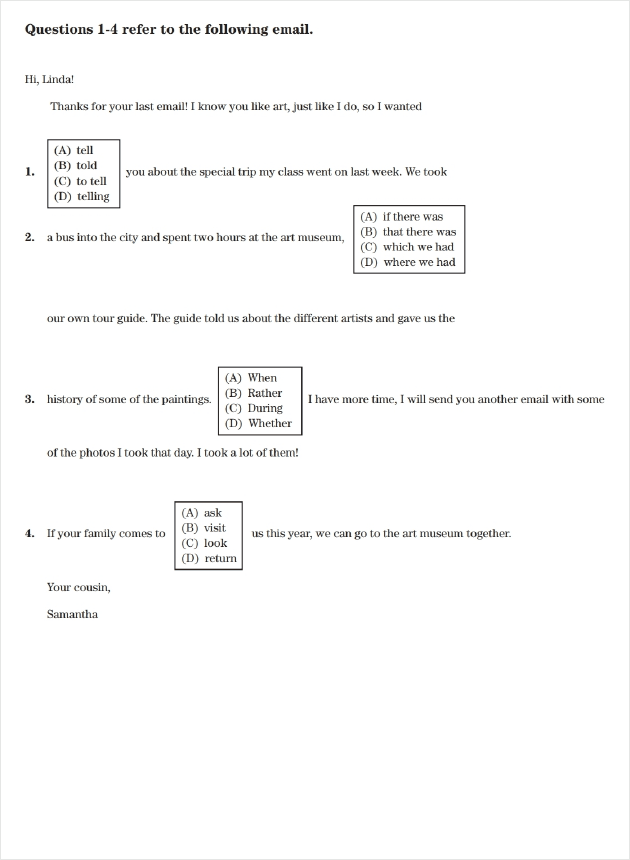
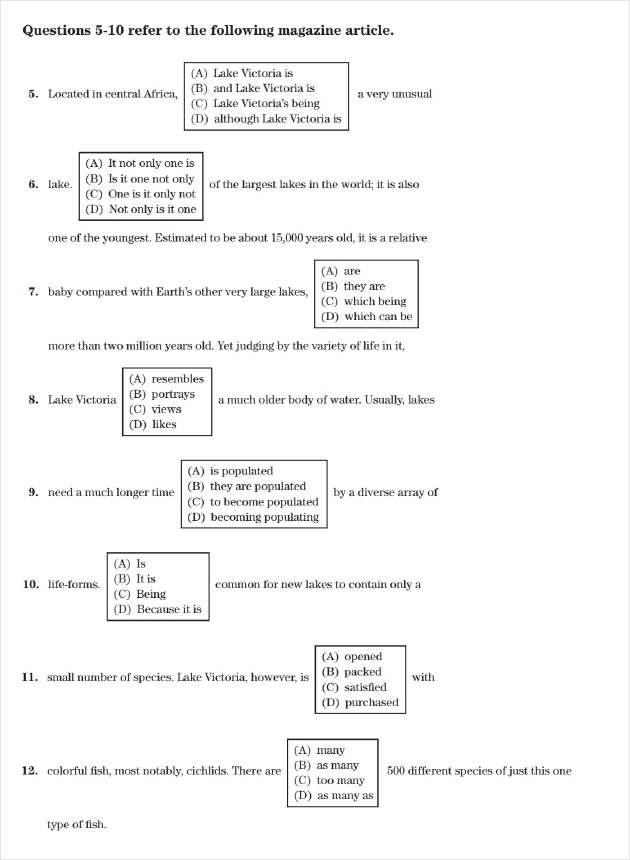
Reading 질문유형 (Example Question)
각 구절을 읽고 나면 그 뒤에 나오는 문항과 가능한 네 가지 답을 읽게 된다.
가장 좋은 답을 고를 것이다.
아래는 읽기 지문과 질문 샘플이다.
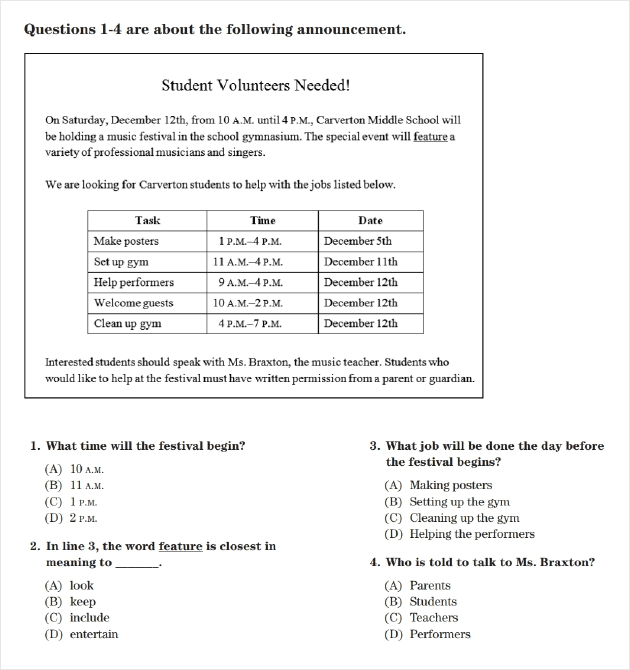
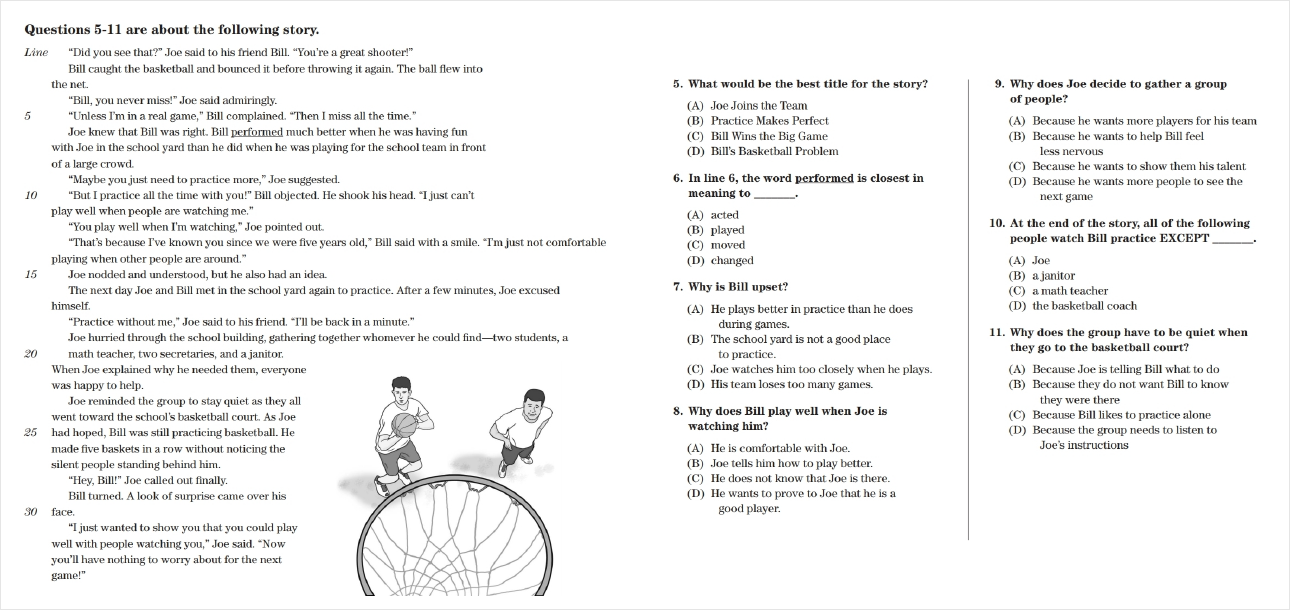
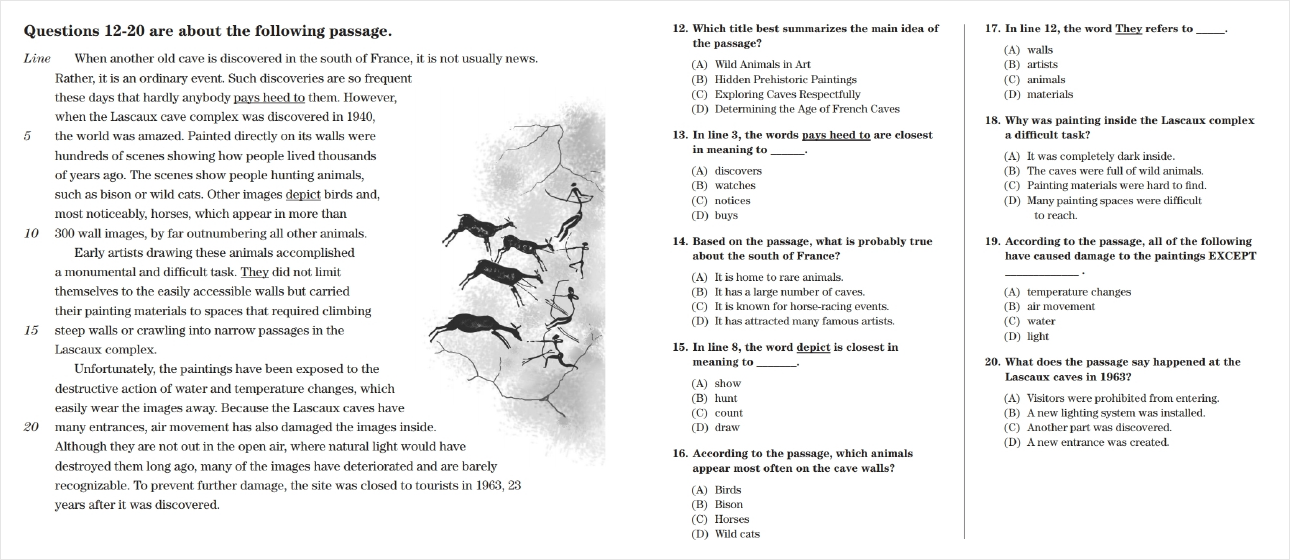
Standard Example Question 정답
| Listening Comprehension Answer Key | |
|---|---|
| 1. C | 6. D |
| 2. D | 7. B |
| 3. A | 8. B |
| 4. B | 9. A |
| 5. A | 10. D |
| Language Form and Meaning Answer Key | |
|---|---|
| 1. C | 7. D |
| 2. D | 8. A |
| 3. A | 9. C |
| 4. B | 10. B |
| 5. A | 11. B |
| 6. D | 12. D |
| Reading Comprehension Answer Key | |||
|---|---|---|---|
| 1. A | 6. B | 11. B | 16. C |
| 2. C | 7. A | 12. B | 17. B |
| 3. B | 8. A | 13. C | 18. D |
| 4. B | 9. B | 14. B | 19. D |
| 5. D | 10. D | 15. A | 20. A |
